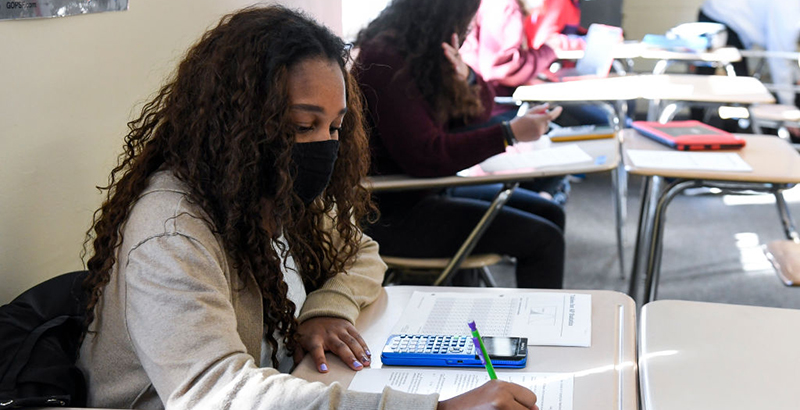‘I Don’t Know that the Tests Would Survive’: As Students Enter Third Pandemic School Year, Researchers Make Case for Assessments

Get stories like this delivered straight to your inbox. Sign up for The 74 Newsletter
In the spring of 2020, facing massive disruptions to in-person instruction, state education chiefs urged then-U.S. Education Secretary Betsy DeVos to waive federal test requirements that had been in place for nearly 20 years.
She granted a blanket, one-year “accountability waiver.” But in February, with a new administration in place, then-Education Secretary nominee Miguel Cardona said he’d require states to administer the federally mandated tests in the spring, with an asterisk: They had the option of giving shorter, remote, or delayed versions.
Now, as students begin a third year of school under the cloud of COVID-19, a pair of researchers suggest that those two moves, by two administrations, may have made the results of annual testing less valuable — and could harm the delicate political support such testing still enjoys.
Using different versions of tests makes the results less comparable across different years and school districts. And shorter tests produce less “actionable” information about individual student achievement in the short term, said Dan Goldhaber of the National Center for Analysis of Longitudinal Data in Education Research at the University of Washington.
“The waivers looked to us like they made state tests less useful for diagnostic purposes, both for parents and for teachers,” Goldhaber said in an interview.

In a new policy brief, Goldhaber, along with Paul Bruno of the University of Illinois at Urbana-Champaign, say that as states begin planning for next spring’s tests, they should consider exactly how useful the results are for families, who spent much of the past school year getting an up-close look at just how much their children know.
When these tests return full-force in schools post-pandemic, as they likely will in 2022, they run the risk of being out-of-step with parents’ new, pandemic-fueled understanding of their children’s needs, the authors warn.
If the test results can’t help guide decisions about student placement and skills levels, they could lose what tenuous political support they still have, according to the analysis.
The researchers looked at testing policies nationwide and found that in most states, educators use tests either for diagnostics, for research and evaluation, or as the basis for accountability systems.
But they might also be better used to provide “actionable and timely information” about how to help individual students do better in the subjects tested. If results could be disaggregated more often and in a timely fashion, they say, that would help parents and teachers look more closely at students’ skill levels and academic needs.
As it is, they say, state test results “often take several months to make it into the hands of educators or families, impeding the use of testing to help individual students.”
“We need to make sure, I think, that they are useful for more than just accountability purposes,” said Goldhaber, who is also affiliated with the American Institutes for Research.
He noted, for instance, that in Washington State, many high-achieving students in underrepresented minority groups, who wouldn’t typically be assigned to advanced classes, get that option based on end-of-year assessment results. “They’re used for those kinds of things, but I don’t think it’s well-known,” he said.
Twenty years after No Child Left Behind first mandated widespread spring testing in K-12 schools, the authors say refocusing the tests could also keep them from losing popular support among parents and teachers.
Federal testing requirements are “popular in the abstract,” Bruno and Goldhaber write, but that support appears fragile: 41 percent of respondents in a 2020 Phi Delta Kappa poll said there’s “too much emphasis on achievement testing” in public schools, up from 37 percent in 2008 and just 20 percent in 1997.
They also note that support for testing drops 20 percentage points when respondents are told that test administration takes, on average, eight hours of class time annually.
“I think there’s probably less public support than there was, certainly, when No Child Left Behind passed” in 2001, Goldhaber said.
Because of remote schooling, Goldhaber said, “Many parents have a window into what’s actually going on inside the classroom, in a way that they did not have before the pandemic, because they could sit in with their kids during classes.”
But in many cases, he said, the test results don’t necessarily offer “concrete information that suggests maybe your kids need help with complex fractions — the kind of information that you could at least imagine would inform parent-teacher meeting discussions.”
Jonathan Schweig, a researcher at the RAND Corp. and a professor at Pardee RAND Graduate School who studies education policy and teacher evaluations, among other topics, said he generally agreed with Bruno’s and Goldhaber’s notion that using tests for diagnostic purposes might be a way to increase public support.
Echoing Goldhaber’s point about concrete data, he said state summative tests generally “were not designed to provide diagnostic or instructionally useful information. Even under routine conditions, the tests are administered towards the end of the school year, and score reports are returned to schools and families during the summer, after the school year has ended.”
Schweig also said the scores generated by these assessment systems “are not at a grain size that would be useful to support remediation or other diagnostic uses.”

Summative tests, he said, “are best thought of as providing one piece of information about student learning, but they do not provide the only piece and perhaps not even the most important piece. As such, it is important for school leaders to think comprehensively about assessment and design coherent systems that include a mix of formative, interim and state-wide summative assessments.”
Any broad new federal testing policies will have to wait until Congress approves a reauthorization of the Elementary and Secondary Education Act, which helps fund public schools. That could take years, since lawmakers typically push back the timeline for reauthorization by years. But in today’s political climate, Goldhaber said, “I think that if we were to have a negotiation right now, I don’t know that the tests would survive.”
Get stories like these delivered straight to your inbox. Sign up for The 74 Newsletter

;)
